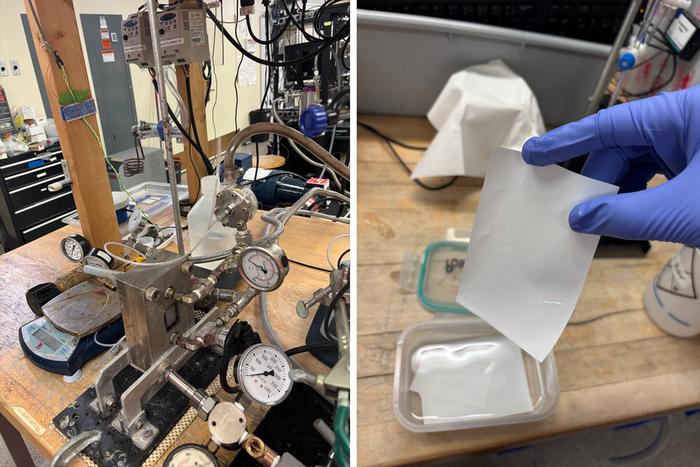Aluminum, the second-most produced metal after steel, is critical in an array of applications, from the packaging industry to automotive and aerospace sectors. The urgency surrounding aluminum production has grown, with projections indicating a significant 40 percent increase in global demand by the end of the decade. This burgeoning demand raises serious environmental concerns about the associated hazardous waste generated during aluminum manufacturing processes, particularly as pollutants enter the ecosystem. Addressing these environmental impacts is increasingly essential as industry stakeholders seek solutions that align production efficiency with sustainable practices.
In a groundbreaking advancement, engineers at the Massachusetts Institute of Technology (MIT) have introduced a pioneering nanofiltration technique aimed at mitigating the hazardous waste resulting from aluminum production. This innovative method focuses on processing aluminum plant waste streams to recover aluminum ions. Such recovery initiatives have the potential to substantially increase aluminum yields while minimizing environmental degradation, promoting a more sustainable approach to aluminum production.
The researchers conducted extensive laboratory experiments demonstrating the efficacy of a novel membrane designed to filter solutions closely resembling the waste byproducts of aluminum manufacturing. Results from these tests indicate that the membrane effectively captures over 99 percent of aluminum ions from these simulated waste streams. This impressive performance could revolutionize how aluminum manufacturers manage waste, decreasing the amounts of aluminum lost during production while concurrently improving the overall environmental profile of manufacturing facilities.
By scaling this innovative membrane technology to industrial capacities, existing aluminum production plants could see a dramatic reduction in wasted aluminum. The implications of such a change not only pertain to waste management but also to broader ecological benefits, as the filtration process helps reduce the volume of harmful byproducts released into the environment. The technology epitomizes a vital shift towards a circular economy in aluminum manufacturing, advocating for environmental stewardship while meeting escalating production needs.
John Lienhard, the Abdul Latif Jameel Professor of Water in the Mechanical Engineering Department and director of the Abdul Latif Jameel Water and Food Systems Lab at MIT, commented on the transformative nature of this membrane technology. He emphasized how it significantly diminishes hazardous waste and contributes to a circular economy model for aluminum, ultimately minimizing the necessity for raw material extraction. This approach not only addresses pressing environmental issues but also aligns with industrial demands for aluminum.
The collaborative effort between Lienhard’s research group and undergraduate students at MIT resulted in a study published in the journal ACS Sustainable Chemistry and Engineering. The research team identified aluminum production’s overlooked facets, particularly concerning the wastewater produced during aluminum extraction. Following an overview of traditional aluminum production processes, which begin with surface mining bauxite ore and lead to the generation of aluminum oxide or alumina, the researchers set forth to investigate feasible recycling pathways for waste materials.
The challenge encountered in aluminum production arises from the output of spent cryolite, a viscous sludge laden with impurities and residual aluminum ions—a byproduct generated during the electrolysis process used to separate aluminum from alumina. Lead author Trent Lee pointed out that approximately 2,800 tons of aluminum can be wasted annually, underscoring the critical need for innovation in recycling and efficiency strategies within the industry.
In their research, the team focused on developing a membrane capable of filtering cryolite waste to recover aluminum ions while simultaneously allowing other ions such as sodium to pass through. This sophisticated approach sought to optimize the recycling process by returning recovered aluminum to the electrolysis vat without increasing sodium levels that could hamper production efficiency.
The researchers utilized commercially available membranes in collaboration with the Japanese company Nitto Denko to assess their functionality in selectively filtering ions in the cryolite waste stream. Typically, conventional membranes are designed with a thin polymer sheet housing tiny pores, engineered to allow specific ions to pass while rejecting others. However, in this case, both aluminum and sodium ions bear positive charges, making their separation more complex.
To tackle this, the team adapted the membrane design by incorporating a positively charged coating. This adjustment strategically enables the membrane to repel and capture aluminum ions more effectively, while still permitting the passage of sodium and less positively charged ions. The results indicated that the new membrane successfully captured approximately 99.5 percent of aluminum ions from test solutions, demonstrating its potential applicability for real-world industrial scenarios.
Testing showed that the membrane maintained strong performance under different pH conditions, including solutions with high acidity that align with typical cryolite waste characteristics. This resilience confirms the membrane’s adaptability to the challenging conditions often faced in processing waste streams.
The scale-up for industrial use involves envisioning a membrane of considerable size, in a configuration akin to those utilized in desalination plants, where spiraled membranes process large volumes of water. This adaptation allows for more efficient processing of waste cryolite in a commercial context, paving the way for enhanced recycling capabilities within the aluminum manufacturing sector.
This research not only sheds light on the current recycling practices in aluminum production but also provides a framework for future developments in the field. The implications of this membrane technology extend beyond simple waste reduction, highlighting the potential for innovative solutions that harmonize environmental sustainability with industrial productivity.
In conclusion, the introduction of this nanofiltration technique represents a significant breakthrough in waste management within the aluminum industry. It champions the ideals of resource circularity while drastically minimizing the ecological footprint of aluminum manufacturing processes, ultimately fostering a paradigm shift towards sustainable industrial practices. The continued exploration and implementation of such innovations are crucial as the demand for aluminum escalates globally, reinforcing the need for responsible resource management in aligning economic growth with environmental integrity.
Subject of Research: Nanofiltration technology for aluminum production waste recovery
Article Title: Enhancing Resource Circularity in Aluminum Production Through Nanofiltration of Waste Cryolite
News Publication Date: October 2023
Web References: ACS Sustainable Chemistry and Engineering
References: doi:10.1021/acssuschemeng.4c07268
Image Credits: Photo by Trent Lee
Keywords: Aluminum Production, Nanofiltration, Environmental Sustainability, Waste Management, Circular Economy, Hazardous Waste Recycling, Electrolysis, Membrane Technology, Resource Circularity.




